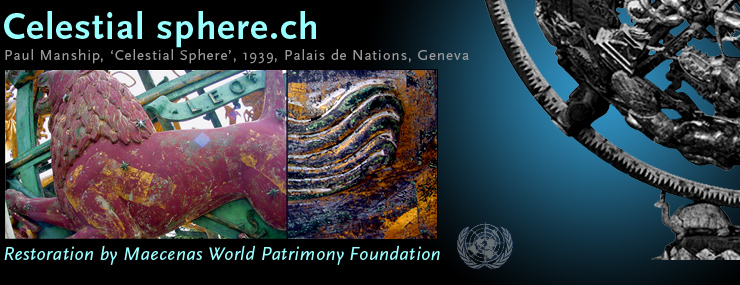| |
|
|
The Problems
The sphere began to have significant problems as early as 1942. The alloy used by the Bearzi Atelier contracted so sharply during winter that water could and did enter the hollow constellations. Gradually a considerable amount of water got inside them and the freezing of that water caused the metal to crack. Already several of the constellations had to be repaired in 1942-43 and at least one cover of a meridian had to be replaced after falling off. "Weep holes" were drilled in all of the constellations at that time to allow water to drain out.
The rotation motor of the Celestial Sphere, was not used during 1940-1945 and ceased to function in the early 1960's. Attempts to repair this problem in the 1970's failed. While the original electric motor which turned the sphere is still in situ, it was buried under concrete in 1974. The original drive shaft, which was external to the sphere, running alongside one of the lower meridian covers to the hub, was removed in 1983. The brass gears installed by Bearzi in 1939 now have lost their teeth due to hand-turning the sphere.
The lack of rotation has caused the sphere to weather very unevenly. This has stripped the gilding from most constellations and left an uneven surface on the remainder. Overall, the gilding has worn badly. This has exposed several colours of underlying 'bole'.
The socle, which bears the whole of the 5.800 kg weight, has cracked. This is in part due to the fact that the concrete pedestal has tipped, probably through settling, shortly after installation. These cracks were widened by a restoration attempt in 1983 during which the constellations were removed from the sphere cage. The sudden relief of pressure and then the re-application of that pressure, when the constellations were returned, is most likely the cause.
Presently, large areas of on-going corrosion were noted by the experts. The architectural aspects of the sphere, meridians and polar axis exhibit large areas of corrosion and surface degradation including some areas of bronze disease. Uneven natural patina was also seen. Testing has revealed large spots of copper oxide and basic copper sulphates caused primarily through acid deposition in dew, fog, snow and rain. These areas of discoloration lay over extensive surface pitting. Other corrosion products, such often found in urban bronze or bronze alloyed monuments, can be expected to be found after further analysis as well as organic depositions and photo-chemically induced reaction products.
The 840 chrome-plated stars, once present in four sizes, have been widely lost. The constellation 'Canis Minor' is now lacking as well.
Stress calculations made in 1983 and again in 2000 indicate that the sphere cage is on the edge of its weight bearing load. Simple hand pressure to the upper surfaces causes the cage to deflect, like a bounced ball. Gradually metal fatigue, cracks and corrosion more and more destabilise its situation. The chances are high that the sphere cage will collapse completely in severe winter climate or in fact with anything causing even a slight change in pressure.
In short: today the state of the Celestial Sphere is most critical.
|
|
|
| |
| |
|
|
